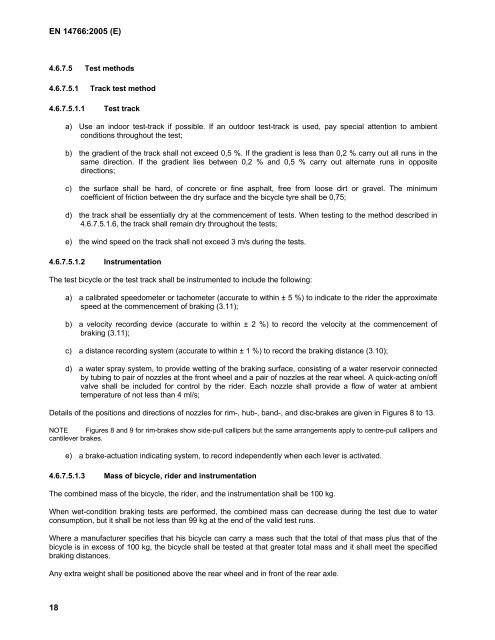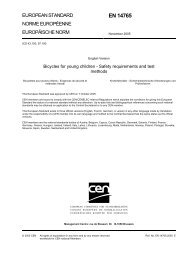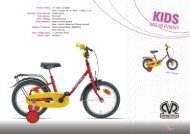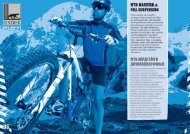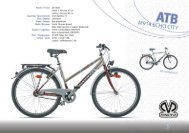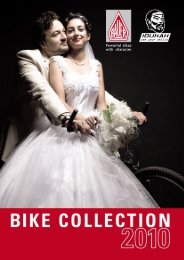EN 14766:2005 - 64_e_stf - Baltik vairas
EN 14766:2005 - 64_e_stf - Baltik vairas
EN 14766:2005 - 64_e_stf - Baltik vairas
- No tags were found...
You also want an ePaper? Increase the reach of your titles
YUMPU automatically turns print PDFs into web optimized ePapers that Google loves.
<strong>EN</strong> <strong>14766</strong>:<strong>2005</strong> (E)4.6.7.5 Test methods4.6.7.5.1 Track test method4.6.7.5.1.1 Test tracka) Use an indoor test-track if possible. If an outdoor test-track is used, pay special attention to ambientconditions throughout the test;b) the gradient of the track shall not exceed 0,5 %. If the gradient is less than 0,2 % carry out all runs in thesame direction. If the gradient lies between 0,2 % and 0,5 % carry out alternate runs in oppositedirections;c) the surface shall be hard, of concrete or fine asphalt, free from loose dirt or gravel. The minimumcoefficient of friction between the dry surface and the bicycle tyre shall be 0,75;d) the track shall be essentially dry at the commencement of tests. When testing to the method described in4.6.7.5.1.6, the track shall remain dry throughout the tests;e) the wind speed on the track shall not exceed 3 m/s during the tests.4.6.7.5.1.2 InstrumentationThe test bicycle or the test track shall be instrumented to include the following:a) a calibrated speedometer or tachometer (accurate to within ± 5 %) to indicate to the rider the approximatespeed at the commencement of braking (3.11);b) a velocity recording device (accurate to within ± 2 %) to record the velocity at the commencement ofbraking (3.11);c) a distance recording system (accurate to within ± 1 %) to record the braking distance (3.10);d) a water spray system, to provide wetting of the braking surface, consisting of a water reservoir connectedby tubing to pair of nozzles at the front wheel and a pair of nozzles at the rear wheel. A quick-acting on/offvalve shall be included for control by the rider. Each nozzle shall provide a flow of water at ambienttemperature of not less than 4 ml/s;Details of the positions and directions of nozzles for rim-, hub-, band-, and disc-brakes are given in Figures 8 to 13.NOTE Figures 8 and 9 for rim-brakes show side-pull callipers but the same arrangements apply to centre-pull callipers andcantilever brakes.e) a brake-actuation indicating system, to record independently when each lever is activated.4.6.7.5.1.3 Mass of bicycle, rider and instrumentationThe combined mass of the bicycle, the rider, and the instrumentation shall be 100 kg.When wet-condition braking tests are performed, the combined mass can decrease during the test due to waterconsumption, but it shall be not less than 99 kg at the end of the valid test runs.Where a manufacturer specifies that his bicycle can carry a mass such that the total of that mass plus that of thebicycle is in excess of 100 kg, the bicycle shall be tested at that greater total mass and it shall meet the specifiedbraking distances.Any extra weight shall be positioned above the rear wheel and in front of the rear axle.18


